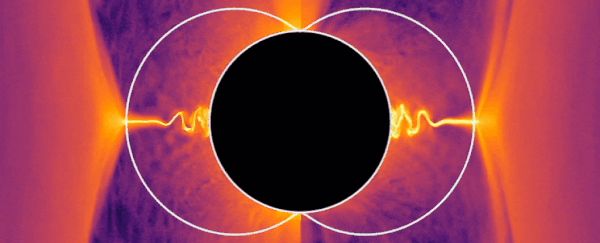When a black hole is actively feeding, something strange can be observed: enormously powerful jets of plasma shoot from its poles, at velocities approaching light speed.
Given the intense gravitational interactions at play, exactly how those jets form is a mystery. But now, using computer simulations, a team of physicists has hit upon an answer - particles seeming to have "negative energy" extract energy from the black hole and redirect it to the jets.
And this theory has, for the first time, united two different and seemingly irreconcilable theories about how energy can be extracted from a black hole.
The first is called the Blandford-Znajek process, and it describes how a black hole's magnetic field can be exploited to extract energy from its rotation.
As material in the accretion disc swirls ever closer to the event horizon, the theory states, it grows increasingly magnetised, producing a magnetic field. Inside this field, the black hole acts as a spinning conductor, inducing voltage between the poles and the equator; this voltage is discharged from the poles as jets.
The second is called the Penrose process, and it relies on conservation of momentum rather than magnetism. The rotational energy of a black hole is located not inside the event horizon, but in a region just outside of it called the ergosphere, which comes into contact with the event horizon at the poles.
According to the Penrose process, if an object inside this region broke apart, with one piece hurtling towards the black hole and the other flung outwards, against the spin of the black hole, the outward-bound piece would emerge with more energy, extracted from the rotation. This produces a sort of 'negative energy'.
Both of these scenarios are compelling, but until now we weren't sure of the correct answer.
"How can the energy in a black hole's rotation be extracted to make jets?" said theoretical physicist Kyle Parfrey of the Lawrence Berkeley National Laboratory. "This has been a question for a long time."
The team designed a simulation of collisionless plasma (wherein particle collisions don't play a major role) in the presence of a black hole's strong gravitational field. They also accounted for the creation of electron-positron pairs in the electric fields, which allowed for more realistic plasma densities.
The resulting simulation naturally produced the Blandford-Znajek process - electrons and positrons moving in opposite directions around the black hole, producing energy in the electromagnetic field that shoots out of the poles as jets.
But it also produced a variation of the Penrose process. Because of relativistic effects, some particles seemed to have "negative energy" when they disappeared into the black hole - which slowed the black hole's rotation, just a tiny fraction.
"If you were right next to a particle, you wouldn't see anything weird about it. But to a distant observer, it looks like it has negative energy," Parfrey told New Scientist.
"You're left with this strange case where if it falls into the black hole, it will cause the mass and the rotation to decrease."
The effect didn't actually contribute very much to the overall energy extraction, Parfrey noted, but it's possible that it is somehow linked to the electric currents that twist the magnetic fields.
The simulation is also missing some components, such as the accretion disc, and the physics of the positron-electron creation is not as detailed as it could be. The team will be working to develop an even more realistic simulation to study the process in greater detail.
"We hope to provide a more consistent picture of the whole problem," Parfrey said.
The team's research has been published in the journal Physical Review Letters, and can be read in full on arXiv.
